The Final Yamato feature film was met with more media coverage than any of its predecessors. Ever the marketeer, Producer Yoshinobu Nishizaki put as much energy into publicity as he did into the film itself. His devotion to both should be evident in this 1983 essay, originally published in the Final Yamato “Roman Album.”
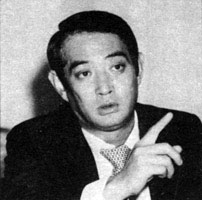
Yoshinobu Nishizaki: planning,
original story, script, director,
producer
Producer Nishizaki gave his full passion to Final Yamato, sacrificing even sleep for it. He was deeply involved in the production, not resting until he reached the film’s opening day. Immediately after production wrapped, he started his next project, the re-release of Final Yamato in 70mm with 4-channel sound. We asked the busy Nishizaki to talk about the production of Final Yamato and his future plans.
We were able to make wholly new kinds of images.
Our schedule was really tight. During the eleven days before the release, we stayed at Toei Studio, mainly in the sound lab. It took time for us to perfect the last scenes of Kodai and Yuki.
Although the sponsors pushed us to make it in time for the release day, I thought it was better to take responsibility for late completion rather than make a bad movie and upset my fans. I had to insist that the movie wasn’t ready yet. I think my stubbornness made the last scenes better, although I understand it won’t be an acceptable excuse for the more than 30 theaters that could not debut the movie on time. Without the last scenes, our reputation would have been tarnished. This was a tough thing to do. I really must compliment the efforts of our editor, Yutaka Chikura.
On March 18th, the night before the release, prints were delivered by truck to Nagoya, Osaka, and the Shikoku region. At the time, I heard that it was snowing around the Sekigahara area, and it might delay the film’s opening. But the truck left Osaka at 4 in the morning on the 19th and delivered the prints in time for the earliest show. I heard about it later, and I was very impressed. The prints were delivered to local areas by plane, and theatre owners in Tokyo and its suburbs actually came to the Toei Studio to get their prints. Seeing so much effort and passion to release the movie on time brought tears to my eyes.
The production crew did a really good job. There were many incredible scenes, due to the shooting techniques of Toei Motion Pictures. I would especially like to thank Mr. Yukio Katayama and Mr. Masao Shimizu. The water scenes were made possible by the technique of Mr. Koichi Tsunoda. The use of “Scanimate” was also employed. Another technique called “kineko” is used to depict a soft atmospheric effect. This helped make the images more realistic.
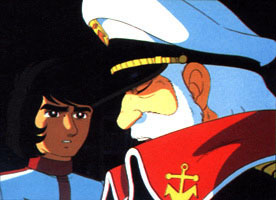
I am very proud of my staff’s work, especially the scenes by the younger artists and the very detailed storyboards by Takeshi Shirado. Masaharu Endo and I created the last scenes of Okita and Kodai in the captain’s room. We carefully described their emotions, and Kodai finally called Okita “father.” Kodai’s emotion was more carefully emphasized than in any other animated movie that came before, which was very satisfying for me as a director. However, I think it would have been even better if we had two more months to spend on it.
Of course, Tomoharu Katsumata, the art director, made this production different from the previous ones. In terms of music, Yamato is mature enough to satisfy an adult audience. In short, Final Yamato turned out to be completely different from previous stories. I think it will be a good guideline for those who are planning to make animation in the future. They will see that we did not repeat the same old patterns this time.
I did not expect to move the audience to tears with the scenes of Yamato sinking. Instead, I thought the most moving scenes would be Shima’s death, the Denguil boy’s death, and the moment Kodai called Okita “father.” My plan was to move the audience to tears with these three scenes.
I wanted to impress them with the graceful last scene of the ship. That is why we used the magnificent piano concerto instead of a sad and touching song for the scene in which the planet Aquarius approaches Earth. I wanted to respect Okita’s comment, “The only thing left for me is Yamato.” Okita and Kodai did not have many conversations in that scene because I thought too many words would be over-explanatory. In the captain’s room, Okita said to Kodai “If you die, what about Yuki?” and went on to say, “The only thing left for me is Yamato. You will understand my feelings later.” I was trying to convey Okita’s implied message that a young man like Kodai had to continue his life until he finally reached the end. It is not necessary to explain this in detail. The pictures will say it all.
Although it is almost impossible for a producer to be fully satisfied regardless of how many revisions are done, I am satisfied to some extent with our work and the organization of the story. In the end, I did what I wanted to do. What I regret the most was the limited amount of production time. Because of this, the movie was not 100% perfect.
Making Final Yamato was 80% harder than usual.
Final Yamato dealt with more serious themes than our previous movies. It wasn’t just about love or romance, it was something deeper and more serious. Also, it was difficult to skillfully depict the characters’ changing emotions in the storyboard stage. Our target audience had been age 13-15 before, but this time we also targeted an older audience, so we needed to emphasize the dramatic aspects of the movie. We wanted to leave a legacy for the future of anime movies. For example, we used different lighting effects to distinguish between the types of energy beams used by the different sides. Two colors were used for the hyper radiation missile. The explosion scene and the warp process of Aquarius required cutting-edge techniques. We also employed scanimate and slitscan.
For these reasons, every phase of production, from drawing cels to the special effects, was 50% or 80% harder than normal.
It took longer than we expected to make a movie that met all the demands. We never cut corners. Normally, after a few months of production, when we feel time is running out, we will decide to cut some scenes, but we didn’t do that this time. Up to the very last moment, we tried to create something new and innovative. Of course, it was very hard, but since we all were on one team, we could make it despite the crazy schedule.
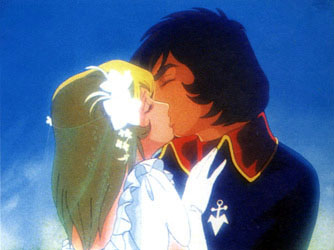
The long-awaited wedding scene that almost didn’t
make it into the film
As a result, only the last scenes between Kodai and Yuki were left to do at the very end. The movie’s release day was postponed in some local theaters because of these scenes. We finished them at the last minute, midnight on March 18th. But I was still not happy with them.
Mori Yuki, who made love with Kodai, glowed with happiness in the last scene, didn’t she? Our initial plan for this scene was for the two who became one (this was an awesome idea) to disappear into space, and the world of Queen Aquarius would fade in. However, because we were not satisfied with the scene of Kodai and Yuki, we only used stills of Aquarius. These, too, were not good enough.
When we revised the scene and eliminated the couple, there was no emotional unity. Therefore, I decided to simply cut the whole sequence, which was about 3.5 minutes. The early morning screenings still had it attached to their prints of the film, so it could only be cut from screenings later in the day.
On the release day, March 19th, we had a party to celebrate the completion of the movie at 1:30 pm. It was at this party, in the presence of the director, editor and all the staff members, that I ordered the last scenes to be cut in all seven of the theaters in Tokyo. At 5:30 pm, I checked the print at Shinjuku Palace to make sure it was cut.
Kodai and Yuki are happy. The Queen of Aquarius calls them “distant offspring of Aquarius.” She also sees Yamato and it disappears into her infinite space. This was the initial plan for the ending. We could not make a good love scene of the couple.
Of course, there were many great concepts for the love scene, but if I had used them in the movie, I thought the audience would react negatively. So we just ended on a close-up of Yuki’s face, full of happiness. Queen of Aquarius was a goddess, the originator of life. By “sinking” Kodai and Yuki into the arms of the Queen, we wanted to express the birth of new life. This was my intention. Even though Yamato is an inanimate object, the idea of reincarnation was applied to it as well. That is why we also sank Yamato into the arms of the Queen. Thus, my ideology was complete.
A movie is a form of entertainment, and therefore it needs a theme. I wanted to express it not in words, but in pictures. I regret that by cutting that last scene, I failed to do this. (Note: since the 70mm revival of Final Yamato was several months off, Nishizaki took advantage of this time to remake the final sequence and fulfill his original plan. Both the original and revised versions can be seen on Voyager’s DVD release of the film.)
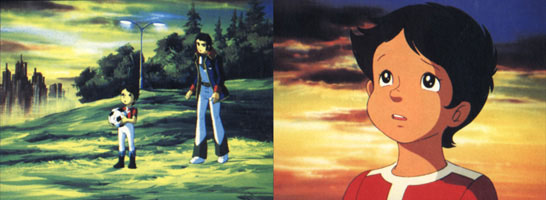
Daisuke and Jiro Shima: rescued from the cutting room floor
Toward the completion of Final Yamato: 70mm and 4-channel sound
Because this will be the finale, we want it to be satisfying. Therefore, we are preparing to re-release Final Yamato later in the year. This version will be in 70mm with 4-channel sound, which we could not do in our initial release. We are spending a lot of time re-editing the picture, and I am sure it will be a great work.
Now, Director Tomoharu Katsumada, Chief Director Takeshi Shirado, Animation Director Kazuhiko Udagawa, Cameraman Yukio Katayama, Assistant Director Kazunori Tanahashi, the recording staff, and I are checking all the scenes from the storyboards to restore them to the film. These are scenes with which we were not happy in terms of picture quality or in which the special effects were partially missing. Some are scenes in which the sound and picture do not match.
Normally, this is not done after a movie is released. However, we all have a special passion toward this movie, so we wanted to do our best to make it perfect. Also, although it will cost 20 to 30 million yen, we decided it was worth doing. Yamato fans also requested that we make this version since they knew that my original scenario was about 4 or 5 hours long.
In fact, the length of the film before we edited it was 3 hours and 28 minutes. This film included some blank parts. We recut it to 2 hours and 29 minutes in the end. That does not mean we intentionally cut many scenes. Personally, I think that the ideal length of the movie would be about 2 hours and 45 minutes. The point is not just to make the movie longer, but to select the best images to make it more dramatic. Therefore, during the editing process, we reused some of the cut scenes and removed unnecessary scenes.
In this movie there are 1800 individual scenes. We are planning to change about ten percent of them, or about 200 scenes. Specifically, we will change the scenes of Aquarius and the love scene with Kodai and Yuki. We had to remove many scenes in the first part of the movie to quicken the pace. In the original version, it was not clear why Yamato was attacked right after the bouquet was thrown, because there was no scene to explain the situation. We did not have time then to revise it, but now we do. Also, the scene with the Shima brothers was cut from the original release. We are rethinking whether to use these scenes, which we first thought were unnecessary, but later we realized that they were important for the story flow.
Aquarius was not good enough in the first release; it is supposed to be more beautiful. This time, I am planning to add more close-up images of Aquarius. I am also planning to reshoot the last scene with Kodai and Yuki until I am finally satisfied with it.
Here is what I really wanted to do: Kodai whispers something to Yuki. Yuki nods slightly to him. Then, their clothes are changed to wedding costumes. There is a twenty second wait before they make love. The twenty seconds is necessary because the message is that this love will make them strong. I wanted a close-up of Yuki’s face that shows her determination, but I could not get a facial expression that satisfied me.
Yuki is lying beneath Kodai, implying that they are making love. After the love-making, there is a close-up of Yuki as she slowly opens her eyes. Women have strong emotions not during lovemaking, but afterward. Yuki slowly closes her eyes and tears fall. This scene implies that they have now become one. Instead of the image of the couple embracing each other, the close-up of Yuki’s face is used. Her happiness for getting her life-long partner is apparent. Kodai looks happy for the same reason.
The very last scene is Yuki’s face as a wife and as a woman. Her face is moving closer to Kodai’s. Their lips almost touch as they disappear into infinite space. This was my original plan. However, there was not time to make these images. This time, I am confident that we can do it.
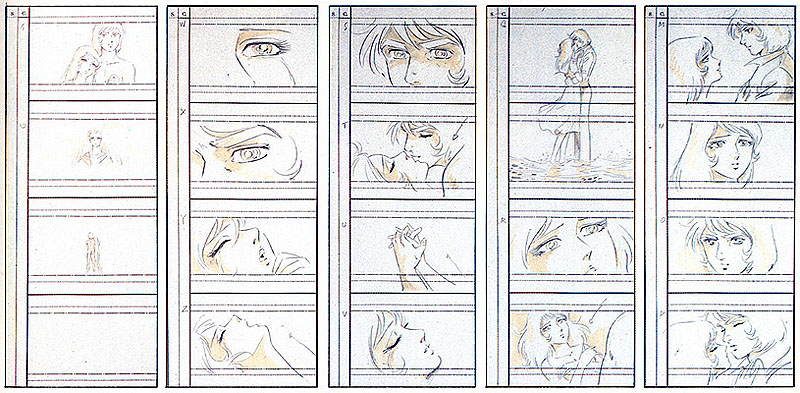
Shinya Takahashi’s storyboard concept for the love scene (Reads right to left)
If I made another story, it would be about Dessler.
Thinking about my career after the re-release of Final Yamato, I am not going to abandon the anime genre completely.
Personally, I think that Final Yamato is only partly final, because I do not want to give up the image of the battleship, which sank in 1945, flying through space.
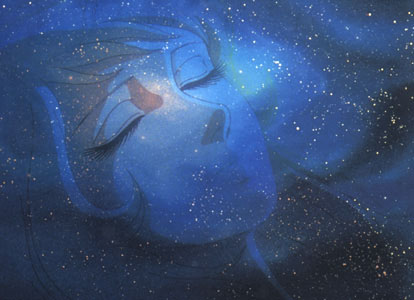
Yuki sinks into an infinite universe of peace and love
There could be no greater theme than this. The main character of Space Battleship Yamato is neither Kodai, Yuki, nor Captain Okita. Actually, we had no main character at all when we first developed the concept. However, I do not want to forget the image of the battleship. This does not mean I am going to make another movie, just that I definitely want to see Yamato traveling across space again someday.
If I were to choose a Yamato-related story to produce in the future, it would be the story of Dessler, the Emperor of Galman/Gamilus.
After Final Yamato, I do not feel like making any anime aside from Yamato. However, I am a little interested in the possibility of telling the story of Dessler. Such a story would have the same flavor, even if Yamato was not in it. Perhaps it can be called the “Nishizaki flavor.”
Imagine, “Dessler is standing alone looking at the faraway winter moon, and the Earth, which becomes gradually more beautiful …” With this, the story is already in my mind. “He is standing alone, quietly looking into space. “Kodai, be happy,” he says. Dessler, who lost his Empire, begins his journey thinking of the prosperity of his people and the continuation of his clan.”
I could easily make this story if I wanted to. Dessler is an incarnation of myself. If I were to start this project, it would be after summer. If there are many requests for it, I will make it.
The End
(Editor’s Note: regrettably, this story never came to pass, despite the enormous interest that followed this announcement. Nevertheless, you can read about the entire development history of the project here.)
Continue to our next Nishizaki article: 1983 retrospective about the entire saga
